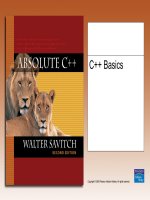Giáo án - Bài giảng: ABSOLUTE C++ : CHAPTER 1 - C++ BASICS
Bạn đang xem bản rút gọn của tài liệu. Xem và tải ngay bản đầy đủ của tài liệu tại đây (697.79 KB, 40 trang )
Chapter 1
C++ Basics
Copyright © 2006 Pearson Addison-
Wesley. All rights reserved.
1-2
Learning Objectives
♦
Introduction to C++
♦
Origins, Object-Oriented Programming, Terms
♦
Variables, Expressions, and
Assignment Statements
♦
Console Input/Output
♦
Program Style
♦
Libraries and Namespaces
Copyright © 2006 Pearson Addison-
Wesley. All rights reserved.
1-3
Introduction to C++
♦
C++ Origins
♦
Low-level languages
♦
Machine, assembly
♦
High-level languages
♦
C, C++, ADA, COBOL, FORTRAN
♦
Object-Oriented-Programming in C++
♦
C++ Terminology
♦
Programs and functions
♦
Basic Input/Output (I/O) with cin and cout
Copyright © 2006 Pearson Addison-
Wesley. All rights reserved.
1-4
Display 1.1
A Sample C++ Program (1 of 2)
Copyright © 2006 Pearson Addison-
Wesley. All rights reserved.
1-5
Display 1.1
A Sample C++ Program (2 of 2)
Copyright © 2006 Pearson Addison-
Wesley. All rights reserved.
1-6
C++ Variables
♦
C++ Identifiers
♦
Keywords/reserved words vs. Identifiers
♦
Case-sensitivity and validity of identifiers
♦
Meaningful names!
♦
Variables
♦
A memory location to store data for a program
♦
Must declare all data before use in program
Copyright © 2006 Pearson Addison-
Wesley. All rights reserved.
1-7
Data Types:
Display 1.2 Simple Types (1 of 2)
Copyright © 2006 Pearson Addison-
Wesley. All rights reserved.
1-8
Data Types:
Display 1.2 Simple Types (2 of 2)
Copyright © 2006 Pearson Addison-
Wesley. All rights reserved.
1-9
Assigning Data
♦
Initializing data in declaration statement
♦
Results "undefined" if you don’t!
♦
int myValue = 0;
♦
Assigning data during execution
♦
Lvalues (left-side) & Rvalues (right-side)
♦
Lvalues must be variables
♦
Rvalues can be any expression
♦
Example:
distance = rate * time;
Lvalue: "distance"
Rvalue: "rate * time"
Copyright © 2006 Pearson Addison-
Wesley. All rights reserved.
1-10
Assigning Data: Shorthand Notations
♦
Display, page 14
Copyright © 2006 Pearson Addison-
Wesley. All rights reserved.
1-11
Data Assignment Rules
♦
Compatibility of Data Assignments
♦
Type mismatches
♦
General Rule: Cannot place value of one type into
variable of another type
♦
intVar = 2.99; // 2 is assigned to intVar!
♦
Only integer part "fits", so that’s all that goes
♦
Called "implicit" or "automatic type conversion"
♦
Literals
♦
2, 5.75, "Z", "Hello World"
♦
Considered "constants": can’t change in program
Copyright © 2006 Pearson Addison-
Wesley. All rights reserved.
1-12
Literal Data
♦
Literals
♦
Examples:
♦
2 // Literal constant int
♦
5.75 // Literal constant double
♦
"Z" // Literal constant char
♦
"Hello World" // Literal constant string
♦
Cannot change values during execution
♦
Called "literals" because you "literally typed"
them in your program!
Copyright © 2006 Pearson Addison-
Wesley. All rights reserved.
1-13
Escape Sequences
♦
"Extend" character set
♦
Backslash, \ preceding a character
♦
Instructs compiler: a special "escape
character" is coming
♦
Following character treated as
"escape sequence char"
♦
Display 1.3 next slide
Copyright © 2006 Pearson Addison-
Wesley. All rights reserved.
1-14
Display 1.3
Some Escape Sequences (1 of 2)
Copyright © 2006 Pearson Addison-
Wesley. All rights reserved.
1-15
Display 1.3
Some Escape Sequences (2 of 2)
Copyright © 2006 Pearson Addison-
Wesley. All rights reserved.
1-16
Constants
♦
Naming your constants
♦
Literal constants are "OK", but provide
little meaning
♦
e.g., seeing 24 in a pgm, tells nothing about
what it represents
♦
Use named constants instead
♦
Meaningful name to represent data
const int NUMBER_OF_STUDENTS = 24;
♦
Called a "declared constant" or "named constant"
♦
Now use it’s name wherever needed in program
♦
Added benefit: changes to value result in one fix
Copyright © 2006 Pearson Addison-
Wesley. All rights reserved.
1-17
Arithmetic Operators:
Display 1.4 Named Constant (1 of 2)
♦
Standard Arithmetic Operators
♦
Precedence rules – standard rules
Copyright © 2006 Pearson Addison-
Wesley. All rights reserved.
1-18
Arithmetic Operators:
Display 1.4 Named Constant (2 of 2)
Copyright © 2006 Pearson Addison-
Wesley. All rights reserved.
1-19
Arithmetic Precision
♦
Precision of Calculations
♦
VERY important consideration!
♦
Expressions in C++ might not evaluate as
you’d "expect"!
♦
"Highest-order operand" determines type
of arithmetic "precision" performed
♦
Common pitfall!
Copyright © 2006 Pearson Addison-
Wesley. All rights reserved.
1-20
Arithmetic Precision Examples
♦
Examples:
♦
17 / 5 evaluates to 3 in C++!
♦
Both operands are integers
♦
Integer division is performed!
♦
17.0 / 5 equals 3.4 in C++!
♦
Highest-order operand is "double type"
♦
Double "precision" division is performed!
♦
int intVar1 =1, intVar2=2;
intVar1 / intVar2;
♦
Performs integer division!
♦
Result: 0!
Copyright © 2006 Pearson Addison-
Wesley. All rights reserved.
1-21
Individual Arithmetic Precision
♦
Calculations done "one-by-one"
♦
1 / 2 / 3.0 / 4 performs 3 separate divisions.
♦
First 1 / 2 equals 0
♦
Then 0 / 3.0 equals 0.0
♦
Then 0.0 / 4 equals 0.0!
♦
So not necessarily sufficient to change
just "one operand" in a large expression
♦
Must keep in mind all individual calculations
that will be performed during evaluation!
Copyright © 2006 Pearson Addison-
Wesley. All rights reserved.
1-22
Type Casting
♦
Casting for Variables
♦
Can add ".0" to literals to force precision
arithmetic, but what about variables?
♦
We can’t use "myInt.0"!
♦
static_cast<double>intVar
♦
Explicitly "casts" or "converts" intVar to
double type
♦
Result of conversion is then used
♦
Example expression:
doubleVar = static_cast<double>intVar1 / intVar2;
♦
Casting forces double-precision division to take place
among two integer variables!
Copyright © 2006 Pearson Addison-
Wesley. All rights reserved.
1-23
Type Casting
♦
Two types
♦
Implicit—also called "Automatic"
♦
Done FOR you, automatically
17 / 5.5
This expression causes an "implicit type cast" to
take place, casting the 17 17.0
♦
Explicit type conversion
♦
Programmer specifies conversion with cast operator
(double)17 / 5.5
Same expression as above, using explicit cast
(double)myInt / myDouble
More typical use; cast operator on variable
Copyright © 2006 Pearson Addison-
Wesley. All rights reserved.
1-24
Shorthand Operators
♦
Increment & Decrement Operators
♦
Just short-hand notation
♦
Increment operator, ++
intVar++; is equivalent to
intVar = intVar + 1;
♦
Decrement operator,
intVar ; is equivalent to
intVar = intVar – 1;
Copyright © 2006 Pearson Addison-
Wesley. All rights reserved.
1-25
Shorthand Operators: Two Options
♦
Post-Increment
intVar++
♦
Uses current value of variable, THEN increments it
♦
Pre-Increment
++intVar
♦
Increments variable first, THEN uses new value
♦
"Use" is defined as whatever "context"
variable is currently in
♦
No difference if "alone" in statement:
intVar++; and ++intVar; identical result









